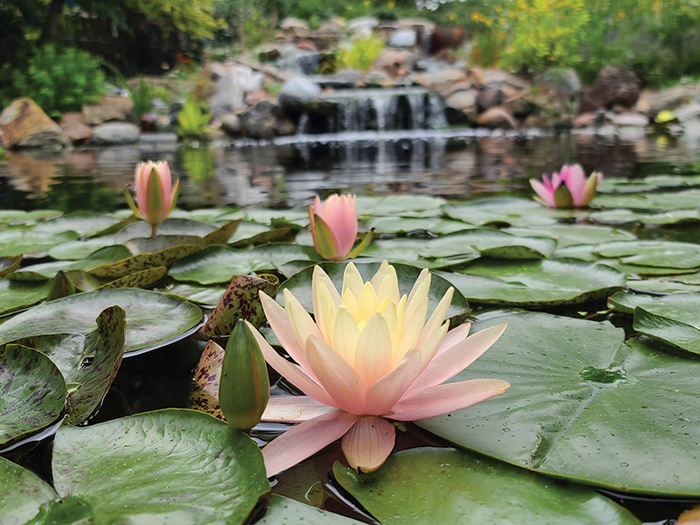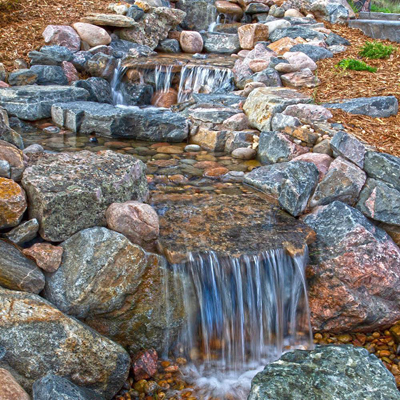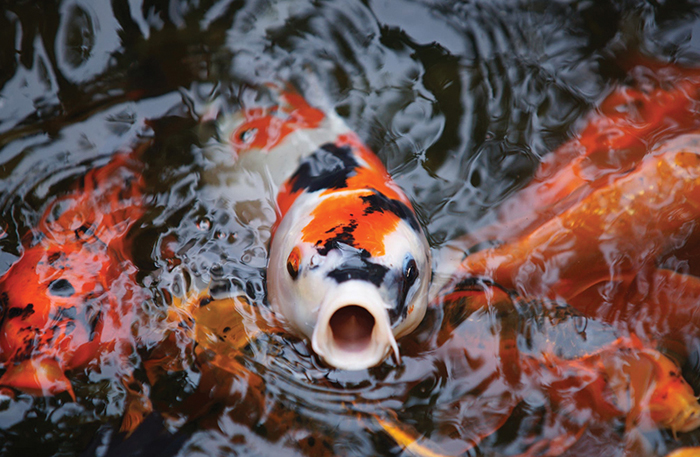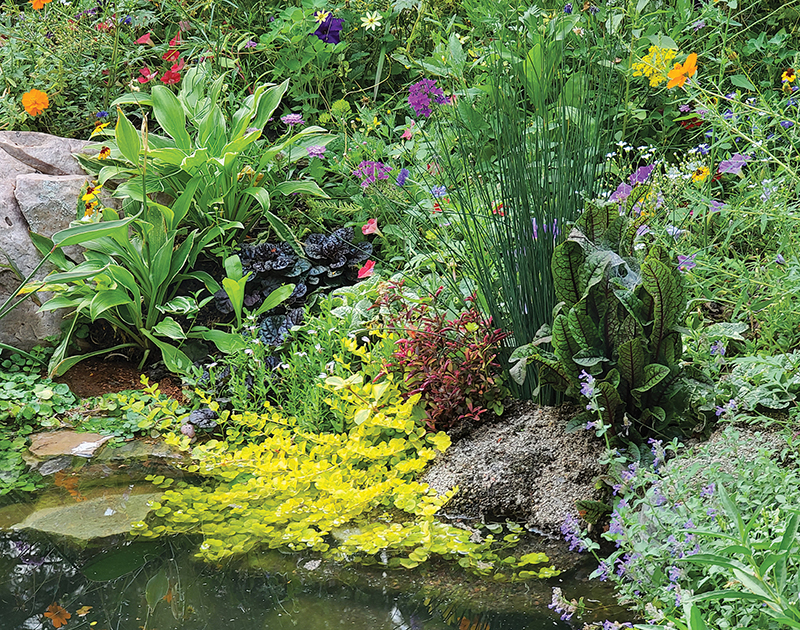
We like to say that anybody can dig a hole and fill it with water. But to master the craft of building water features that function properly with simple maintenance and a proper biological balance, all while exuding a lasting aesthetic beauty — well, it can be a bit more complicated.
When I became a water-feature builder, I not only wanted to create beautiful waterscapes, but I also wanted to build systems that could support life, offer easy maintenance and give the customer exactly what they envisioned. I started out on the hobbyist side, falling in love with the beauty of koi at a young age. I wanted to create a koi pond I could enjoy and grow my love of the hobby.
Unfortunately, there was no such thing as a skimmer, up-flow filters or EPDM rubber liners back then. Ponds were built out of concrete with submerged filtration that, quite frankly, did not do much good. So, although my first pond was nothing short of a disaster, it inspired me to concentrate on mastering my skills as I continued along this wonderful adventure of building ponds.
>> How to Site a Water Feature: A Checklist
I started out focusing on the aesthetics of the feature. Then I moved to filtration techniques, and then to koi. I ended with aquatic plants — something I now find as much joy in as I do koi!
Aesthetics
When working with the aesthetics of a water feature, we tend to use components that disappear into it. For example, we use multiple skimmers with smaller pumps so the skimmers can be tucked away and hidden. This can be achieved in a couple of different ways. First, you can pull the skimmer away from the edge of the feature so it doesn’t break up your edge treatment. You can also cantilever stones to block the skimmer from areas where it can be seen, or simply use a good-quality fake-rock lid.
As far as manufacturers go, we have never locked in with a single one due to the simple fact that every feature is different, requiring different components to function properly. If you only use one manufacturer’s products, you can master that system, but you have limited yourself to that system. At Art of the Yard, we live by the philosophy that we will always use the components that best suit the feature instead of creating water features around the components.Filtration
When considering filtration options, we like to work with systems that can blend in and not take away from the overall aesthetics. For ecosystem-style features, a good bog can be worked into the overall appearance of the feature. An under-gravel grid can also work very well. For more advanced systems or dedicated koi ponds, we like to use pressurized systems that can be located away from the feature. They can be installed in the ground, around the corner of the house or behind some plantings to make sure they do not take away from the overall aesthetics of the final design.
Rock work is always an especially important aspect of any naturally designed water feature. When choosing stones for a feature, we like to use stone that is hard enough so that it will not break down over time. At Art of the Yard, we use a variety stone sizes to give our features a natural blend. Every water feature artist has their own style and techniques that set them apart from other builders. I would recommend studying others’ styles to come up with a system that works best for you.

For us, filtering techniques are constantly evolving, as new and improved methods and products continue to advance. When choosing a filtration system, we like to gauge how much work the homeowner would like to put into maintenance (i.e., How serious a koi enthusiast are they?).
When creating a koi pond, we like to use filtration that forces water changes as part of regular maintenance. We believe that water changes are the single most important tool to ensure good water quality. Filtration solutions that work well with this philosophy include pressurized filters and drum filtration, both of which can work well and coincide with skimmers, bottom drains, an up-flow filter, UVC, bog filters, intake bays and submersible or centrifugal pumps. We like to use a good mix of all these to create the proper system, depending on the desired final experience.
Koi
When getting into koi, it can be a bit daunting with all the Japanese names, the different varieties and the multiple styles of ponds that can support koi. If you go to a koi chat group and ask a question about a koi pond, you will get 100 different answers, each swearing to be the only way.
My advice is, keep an open mind! Start out with simple questions. Does the homeowner only want koi, or do they want to mix in plants? Do they want bottom drains, or do they want a rock bottom? Once you have all this information, you can start planning a feature to fit the needs of the pond.

Things that have helped me immensely through the years include joining a local koi club and asking its members what is most important to them in a successful koi pond. So, go on a tour with your local koi club or water garden society. Talk to people with koi ponds. See what works for them and how much time they put into maintenance. Then, come up with a solution. I have gone to koi farms, talked with breeders and seined my own koi out of mud-bottom ponds, and through every experience, I have learned something new. I continue to learn to this day. If you can, travel to Japan and take in a koi show. You will be amazed at the different techniques that can produce a healthy koi pond.
Aquatic Plants
I think the final and sometimes most overlooked piece of the puzzle is the aquatic plants. Not only do the water plants add aesthetic beauty to the pond, but they also bring wildlife and a healthy balance as well. Without proper plantings, an ecosystem pond is bound to fail. There are so many amazing varieties available to enhance your ponds, including oxygenators, floating plants, bog plants, waterlilies and water lotus — each of which have their own roles to play in a proper balance of your system. The easiest place to start when you notice a problem with water quality is to add more plants.

My love for aquatic plants has taken me all the way to the Amazon rainforest to experience the Victoria Amazonica blooming at night. I have been fortunate enough to experience water lettuce with blooms as big as a quarter. Take a trip to your local botanical gardens and volunteer your time. Work with the water plants and get your hands dirty! Learn how to differentiate between a day-blooming and night-blooming lily just by looking at the leaves. There are so many new hybrid waterlilies coming out, adding to the vast number of aquatic plants already out there that can breathe life into your water features.
As I have progressed in the industry, I have learned that a single conversation with a wise man is better than years of study. Go to (or, as the case may be, Zoom to) all the conferences you can. Learn different techniques. Try different things. Do not be afraid to fail. I have learned more in good conversation industry conferences then I have in years in the field. Anytime an opportunity comes your way where you can learn and grow, take it!



Thank You Shane! Your wisdom and passion shine! I appreciate how candid you are. This article helped me identify where I feel I completely lack within myself to get into water features, and at the very same time is encouraging so much that I still want to try.
We had so much fun on the 2019 build. Having zero experience, except a failed pond install 15yrs prior working for someone else and a major fail, I swore off ponds and cleaning them! The amount we learned in a couple days with yourself and other amazing builders, was fascinating and full of knowledge. I would agree that getting with the Pro’s such as yourself and bumping elbows in classes for a couple days is the best education. Hands on application vs a book and lectured, was a new experience and made a world of difference for the young adults. We enjoy seeing your creations! Congratulations on all of your successes!!